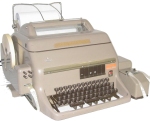Virtual Museum of Radio Communications! |
 Like in
every museum, you will find here a collection of old things from
ancient times. This little private museum is about Utility
Radio, that is about everything on the airwaves, which is
not broadcasting for the public or experimental radio from licensed
radio amateurs, so-called HAMs. Utility Radio is still alive
yet, even your mobile phone is part of the whole thing. But this
little museum will deal with radiocommunications in the frequency
range from 0 to 30 MHz only, the classical long-, medium-, and
short-wave range. Also you will not find very much information
on what is going on in the Utility Radio spectrum nowadays, even
though some of the stations presented here may still be 'on air'. Like in
every museum, you will find here a collection of old things from
ancient times. This little private museum is about Utility
Radio, that is about everything on the airwaves, which is
not broadcasting for the public or experimental radio from licensed
radio amateurs, so-called HAMs. Utility Radio is still alive
yet, even your mobile phone is part of the whole thing. But this
little museum will deal with radiocommunications in the frequency
range from 0 to 30 MHz only, the classical long-, medium-, and
short-wave range. Also you will not find very much information
on what is going on in the Utility Radio spectrum nowadays, even
though some of the stations presented here may still be 'on air'. |
 So what
will you find here? Since more than 50 years I am into the world
of utility radio, the one way or the other. Being a 'collector'
and 'hunter', I have collected 'QSL' reception verifications
from all parts of the world, and I have hunted for many signals
of hard-to-hear utility stations. One day I found, that my private
collection might be the starting point for a website, giving
a short description of a utility station, it's callsigns, the
used frequencies, and so on, and illustrating this with pictures
of 'QSL' verifications, with photos from the antenna farm, with
a link to an actual website, or with one or more soundclips,
where you can hear that station again - most of the stations
described here are 'off the air' now. With the time, many utility
radio experts have joined in, and the collection of pictures
and soundclips is ever expanding. I am sure, it is a real unique
collection of utility-radio related stuff. Still, many gaps are
to be filled, so open your eyes and ears while walking through
this museum, and share your collection here with those who are
interested. So what
will you find here? Since more than 50 years I am into the world
of utility radio, the one way or the other. Being a 'collector'
and 'hunter', I have collected 'QSL' reception verifications
from all parts of the world, and I have hunted for many signals
of hard-to-hear utility stations. One day I found, that my private
collection might be the starting point for a website, giving
a short description of a utility station, it's callsigns, the
used frequencies, and so on, and illustrating this with pictures
of 'QSL' verifications, with photos from the antenna farm, with
a link to an actual website, or with one or more soundclips,
where you can hear that station again - most of the stations
described here are 'off the air' now. With the time, many utility
radio experts have joined in, and the collection of pictures
and soundclips is ever expanding. I am sure, it is a real unique
collection of utility-radio related stuff. Still, many gaps are
to be filled, so open your eyes and ears while walking through
this museum, and share your collection here with those who are
interested. |
Stay tuned... |
 Please
do not expect reference material for actual shortwave listening.
Even though you will find tenthousands of frequency information
on this site, it will not help you to see the actual status of
a frequency. For the first start in 2008, I selected about 2.700
Stations for this museum, but the number of stations increases
with every contribution, now there are more than 4.500 utility
stations featured here, country by country, and more to come... Please
do not expect reference material for actual shortwave listening.
Even though you will find tenthousands of frequency information
on this site, it will not help you to see the actual status of
a frequency. For the first start in 2008, I selected about 2.700
Stations for this museum, but the number of stations increases
with every contribution, now there are more than 4.500 utility
stations featured here, country by country, and more to come... |
How to navigate here? In all listings (countries within a continent, stations within a country) these little symbols tell you what to expect:
When you are on the data page
of a utility radio station, a double-click on the above mentioned
|
